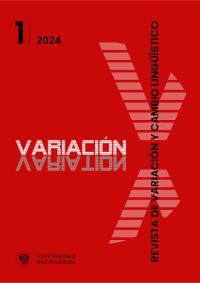Periphrastic constructions as a stylistic resource in the Spanish of Equatorial Guinea: a study based on the literary work of Juan Tomás Ávila Laurel
DOI:
https://doi.org/10.30827/3020.9854rvcl.1.1.2024.31104Keywords:
Spanish language, periphrasis, Equatorial Guinea, Juan Tomás Ávila LaurelAbstract
The Spanish language in Africa in general and its characterization constitutes the essence of our concerns. This article aims to demonstrate, based on a literary corpus, that one of the relevant features of Equatoguinean Spanish are periphrastic constructions as a stylistic resource, to overcome both qualitative and quantitative limitations at the lexical level. We start, by induction, from three novels by the Guinean author Juan Tomás Ávila Laurel to extend our conclusions to a large majority of Equatorial Guineans that we have observed both in Guinea and in Spain. The taste for circumlocutions and periphrases seems to reveal a situation of cultural hybridism and heterolinguism on the one hand; and a lexical insecurity on the other hand. The result can be seen in a hundred illustrations that we have cataloged using stylistic and grammatical criteria.
Downloads
References
Alarcos, E. (1994). Gramática de la lengua española. Real Academia Española. Colección Nebrija. Espasa Calpe.
Almela, R. (1999). Procedimientos de formación de palabras en español. Ariel.
Ávila Laurel, J. T. (2002a). Nadie tiene buena fama en este país. Malamba.
Ávila Laurel, J. T. (2002b). Rusia se va a Asamse. Malamba.
Ávila Laurel, J. T. (2009). Arde el monte de noche. Calambur.
Casado‐Fresnillo, C. (1998). La Lengua y la Literatura españolas en África. Universidad de Melilla.
Crystal, D. (2000). Diccionario de lingüística y fonética. Octaedro.
Fortes, M. (2011, de junio). DIRAE.es, un diccionario inverso del español. Gobierno de Canarias. Consejería de educación, formación profesional, actividad física y deporte.
Lipski, J. (2014). ¿Existe un dialecto “ecuatoguineano” del español? Revista Iberoamericana, 80, 865‐882.
Nguendjo, I. (2009). La creación semántica y léxica en el español de Guinea Ecuatorial. Universidad Complutense de Madrid.
Nguendjo, I. (2014). Contactos lingüísticos afrohispanobantúes. Reflexiones varias (1). Editorial Académica Española.
Penny, R. (2005). Gramática Histórica del Español. Ariel.
Quilis, A. et al. (1986). Lengua española. UNED.
Real Academia Española y Asociación de Academias de la Lengua Española (2009). Nueva gramática de la lengua española. Espasa Libros.
Saussure, F. de (1945). Curso de lingüística general. Losada.
Published
How to Cite
Issue
Section
License
Copyright (c) 2024 VARIACIÓN. Revista de variación y cambio lingüistico

This work is licensed under a Creative Commons Attribution-NonCommercial 4.0 International License.
El autor o autora es la única persona responsable del contenido de su artículo.
Los trabajos enviados a la Revista de Variación y Cambio Lingüístico deben ser originales, inéditos y no haber sido previamente publicados ni estar en evaluación para su publicación en ningún otro formato, ya sea impreso o electrónico.
















